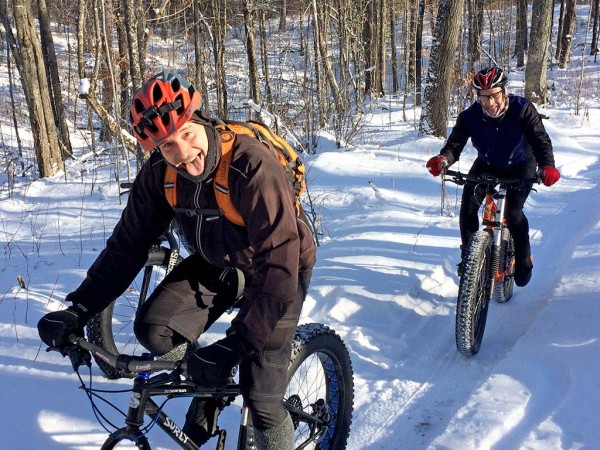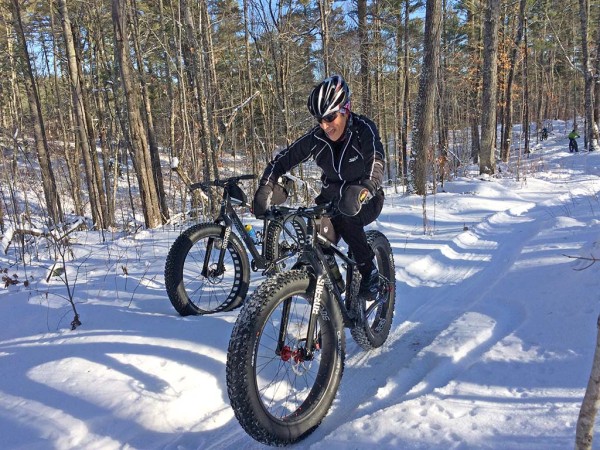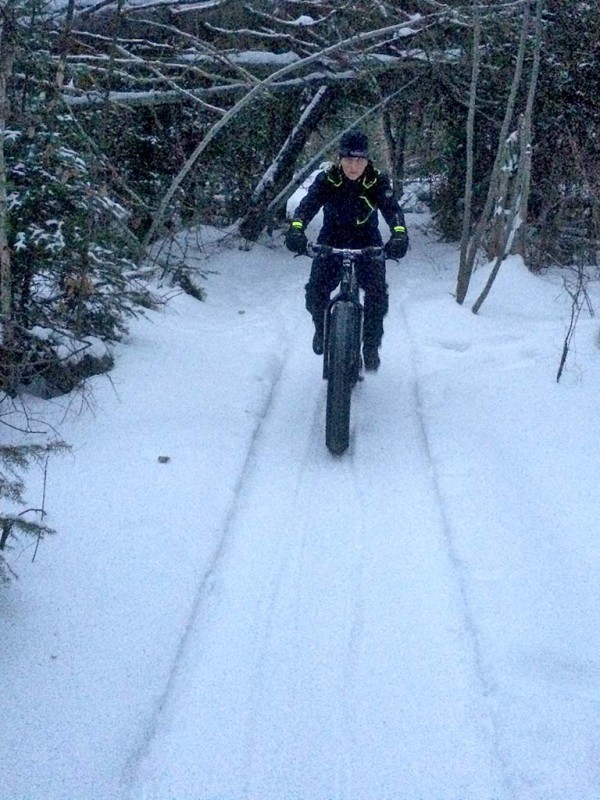With the Fat-bike Birkie just a few weeks off we wanted to let ya’ll know that fat-biking in the Hayward area is not just a one-day deal! Yes, it is true that the Fat-bike Birkie is a single day event and it is the only day you’ll be able to ride the famous American Birkiebiner Ski trail on your fat-bike but the are is home to over 100 miles of MTB trails and CAMBA is grooming more trails for winter fat-biking this year than last. 20-plus miles of dedicated fat-biking goodness! Check out more information from CAMBA below and look for us at the Fat-bike Birkie After Party at the Sawmill in Seely!
More from CAMBA below:
The CAMBA trails are getting fat – as in fat-biking, that is. Through the efforts of a dedicated group of volunteers and enthusiasts, winter fat biking has really begun to take off in the Chequamegon area. Looking like “mountain bikes on steroids,” fat bikes have oversized tires of 3.5 inches to over four and even five inches in diameter. With that much surface area on which to ride, their large tires float over surfaces that would cause a normal sized mountain bike to sink in or bog down. The extra fat tires make them perfect for riding over irregular trail surfaces, sand – as in beach riding, and, of course, snow.
Just because these tires can “float” over snowy trails, doesn’t mean they can go anywhere. Before there is too much accumulated snow, fat-bikers can ride just about any of the CAMBA single track bike trails and pack them down the trail as they go. But once there is a substantial amount of snow, the trails need to be mechanically packed and groomed to support the bikes. The big tires also only require a small amount of air pressure, as low as two pounds per square inch (psi) and rarely more than eight psi. This lower air pressure makes for good traction, a cushy ride, and low impact on the trails.
Snow packed roads and other trails provide other good alternatives for places to ride a fat-bike.
CAMBA does not endorse riding on snowmobiles for obvious safety reasons. At this time most groomed cross country ski trails are not open to fat-bikes. It is widely acknowledged that once a ski trail has firmed up, a fat bike will not do any damage to the trail. It is, however, more of an issue of the user-interface when potentially mixing the uses. Time will tell how this plays out.
The one big exception of course is the Fat Bike Birkie, put on by the American Birkebeiner Ski Foundation in March, when the Birkie Trail will welcomes over 750 fat bikers from across the country. The trail is also open to bikers the day before the event for training. The 2015 Fat Bike Birkie will take place on March 7. For more information, visit http://www.birkie.com/bike/events/fat-bike-birkie/.
An effort to groom winter bike trails in CAMBA country began in Seeley last winter with experimentation with old, smaller snowmobiles that could fit down the relatively narrow CAMBA singletrack. The CAMBA Esker Trail in Cable was also groomed by a regular sized snowmobile with a customized two-foot wide Tidd Tech groomer. Both met with some success, though the huge snows and considerable drifting atop the Esker led to that trail being abandoned this year.
Winter bike trail grooming is a new technology and best practices and equipment are still evolving. Last winter CAMBA hosted the Midwest Fat-bike summit, where presenters from around the upper Midwest shared their experiences and demonstrated various pieces of equipment. Because this is such a new activity, grooming techniques and equipment will need to continue to be perfected.
Recently an enthusiastic group of leaders from the local fat biking community emerged with a goal of moving winter biking forward and creating more places for fat bike enthusiasts to ride. “CAMBA is really encouraged by the energy and passion this group has brought to the effort to develop winter biking in the Chequamegon area,” said Ron Bergin, CAMBA Executive Director. “We look forward to helping make our area a premiere fat-biking destination.”
For the 2015 season, there are two groomed trails – the Seeley Trails and the CAMBA singletrack trail known as Seeley Pass. The Seeley Trails start near downtown Seeley on County Highway OO, just east of US Highway 63 and run through the Urenholdt Forest and on to county land. Seeley Pass starts off County Highway OO near the Birkie Trail and runs almost 12 miles to the intersection with the high point on the Birkie Trail. It is an out and back route. At this point, with over 20 miles of groomed fat bike trails, the Chequamegon area may have one of the largest amounts of groomed winter biking trails in the Midwest.
The Seeley Trails were originally built by local resident and avid mountain biker, Tom Gaier. The singletrack system, intermixed with some double-track and ski trails, is about 10 to 12 miles in length, depending on which “route” is taken. Last year Jeff Schmid, also of Seeley, with Gaier’s assistance, started grooming the trails using a 1972 Ski Doo Elan with a hand-built drag. The Elan has a very narrow track and ski width, which allowed it to travel through the tight bike trails. Although a very simple machine with just a 12 horsepower engine, it was able to climb all of the steep hills, even with a foot of new snow. Schmid recently purchased a Rokon two-wheel drive motorcycle with which he is pulling a new mini-roller to pack the trail. The equipment and grooming techniques are still being dialed in as they learn more about the potential and limitations of the equipment and process.
As additional grooming volunteers and equipment become available, more groomed winter bike trails will be added to this menu. “We have numerous areas and trails that could make great fat biking trails and routes,” says Bergin. The only limiting factor will be the availability of individuals that can groom the trails and having the appropriate equipment.
An overview of winter fat biking can be found on the CAMBA website (http://www.cambatrails.org/page/show/520804-winter-fat-biking) along with trail grooming reports and an opportunity to donate to support winter fat biking in the Chequamegon area.
It is only the beginning of the fat-biking movement in the Chequamegon area. CAMBA and local fat bike enthusiasts fully expect the sport to grow rapidly and quite possibly be the next big thing for the area.



Too bad the Aspen/Snowmass areas do not endorse fatbiking like the other places!